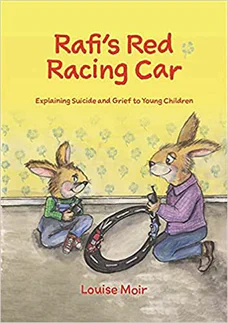Rafi’s Red Racing Car
Explaining Suicide and Grief to Young Children
Written and illustrated by Louise Moir
40 pages
•
Published 2016 (Jessica Kingsley Publishers)

Recommended Age Range: Best for young children–preschool through 1st grade.
Publisher's Summary:
This imaginative, compassionate book aims to help young children come to terms with the loss of a family member to suicide. Rafi’s story explains what suicide is in a sensitive yet honest way, and helps children understand the many overwhelming emotions of grief. Though Rafi struggles with confusion, anxiety, anger and sadness, he learns that his feelings are natural. With love, guidance, therapeutic activities and the fun memories kept alive in his red racing car, he gradually begins to feel happy again.

Dr. Annie's Takeaways
Recommended for: Exclusively for young children who have lost a parent or other loved one to suicide. Best read after the family has had a bit of time to stabilize and reestablish safety and the child has had some time to process what has happened (i.e., not immediately after a suicide, but perhaps several weeks or months later).
Would a child like it? As with the other books on the Bookshelf on this topic, enjoyment is irrelevant here. A child being read this book has experienced a nightmare, and this book could help to start conversations that may prevent further harm (e.g., a child blaming themselves). There’s nothing particularly off-putting about the characters and story, and that’s really all that matters.
Evidence-Based Practices:
Psychoeducation
Tone: Somber, reassuring, ultimately hopeful
Story Quality: The story itself is fairly lukewarm, but for a child who has gone through something as world-altering as a loved one’s suicide, it might not be a bad thing that this story is predictable and even-tempered. The story’s language is developmentally-appropriate yet honest, and the story is loving and ultimately comforting. Could it be more artful? Yes. Does that matter to a child who has found themselves in the position of being read this book? Probably not.
Illustrations: Watercolor illustrations that look a bit like a child drew them. They’re fine but not particularly attractive or evocative.
Representation: Rafi is a male rabbit. His father (also a rabbit) died by suicide. Rafi has a rabbit mother and a counselor who is a female bear. The animals wear human clothes and engage in human activities (playing with toy cars, reading, going to school).
Psychological Practices: The story provides a brief explanation of mental illness and suicide (although for some reason, it never uses this word) and goes into depth about different reactions Rafi has to his father’s suicide (stomacheaches, difficulty sleeping, separation anxiety, worry, anger, behavioral outbursts). Rafi goes to a counselor who reminds him that his father’s suicide was not his fault and helps him start to feel better. Rafi and his mother make a photo album of his father and plant a tree in his father’s honor, and on Rafi’s birthday they release balloons into the sky to include Rafi’s father in the celebration. The story ends with Rafi feeling hopeful that he will feel “alright” again.
Concerns: I’m not sure why this book chose not to use the word suicide. It’s a word that children will hear, and it would have been nice to explicitly name and define this word to prevent if from becoming a word-that-must-not-be-named.
